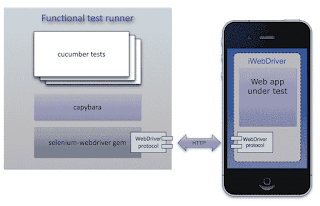Mobile Web Apps with WebDriver
Mobile testing uses mobile web applications manual and complete. Selenium WebDriver
is a browser automation tool. that provides an elegant way of testing
web applications. WebDriver makes it easy to write automated tests. that
ensure site works viewed from an Android or iOS browser.
The WebDriver are few basics helps test web application. WebDriver
tests are end-to-end tests. that exercise a web application a real user
would. There is a comprehensive user guide on the Selenium site covers the core APIs.
Test Mobile Web Apps with WebDriver training in Hyderabad
The Mobile WebDriver
provides touch API. that test web page through finger taps, flicks,
finger scrolls, and long presses. It rotates the display and provides
friendly API to interact with HTML5 features. such as local storage,
session storage, and application cache. Mobile WebDrivers use the remote WebDriver server
client/server architecture. The client piece consists of the test code.
while the server piece is the application installed on the device.
Get Started
The test below opens www.google.com on Android and issues a query for “weather in San Francisco”.
The test will verify that Google returns search results. the first result returned is giving the weather in San Francisco.
When launching test favorite IDE or using the command line. The WebDriver
bring WebView in the web application as the test code is executing.
www.google.com loading the search query typed in the search box.
the WebDriver supports
creating advanced gestures to interact with the device. WebDriver to
throw an image across the screen by flicking, and ensure image in the
gallery.
High-Level Architecture
WebDriver
has two main components: the server and the tests themselves. The
server application runs on the phone, tablet, emulator, or incoming
requests. It runs the tests against a WebView configured like the
browsers. the client side is written in any languages supported by
WebDriver, Java, and Python. The WebDriver communicate with the server
by sending RESTful JSON requests over HTTP. The tests and server pieces have the same physical machine. The Android run tests using the Android test framework remote WebDriver server.
Infrastructure Setup
At Google, we have wired WebDriver tests infrastructure. those tests to run at scale
and making it possible to have them run in our continuous integration
system. External developers run real devices for Android and iOS phones
and tablets.
Android
emulators run on most OSes. they virtualized, so we run them on our
generic cloud setup. there are advantages to using Android emulate a
complete virtual device. it makes the test environment slower. The speed
up the tests by disabling animations, audio, skins. The running in the
emulator headless mode starts the emulator with the options. The tests
to run even faster, start the emulator from a before created snapshot image.
iOS
simulators virtualized and run on Mac machines. But iOS simulators
don’t try to emulate the virtual device or CPU. they run as applications
at full speed test to run much faster.
They tuned for the more mobile feature in Selenium WebDriver.

Comments
Post a Comment